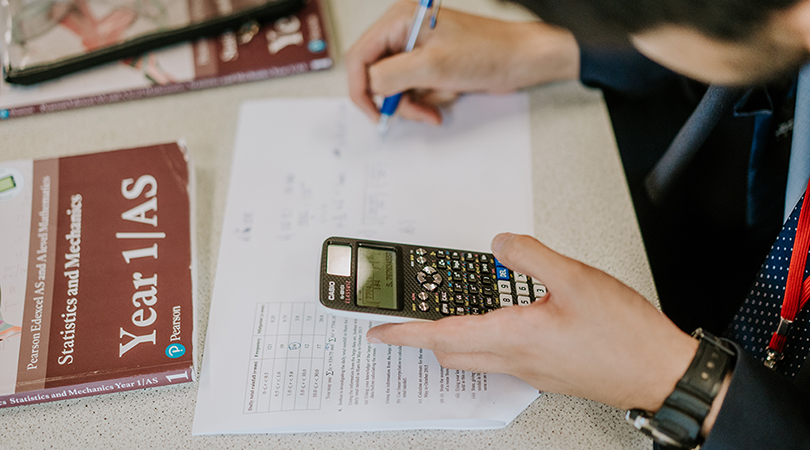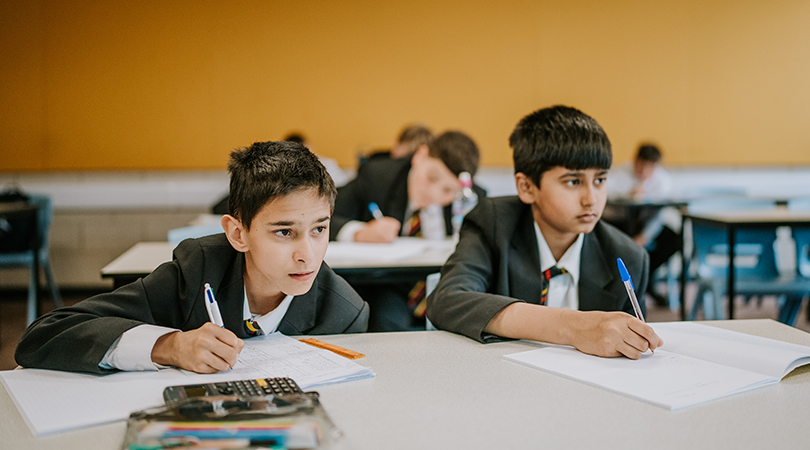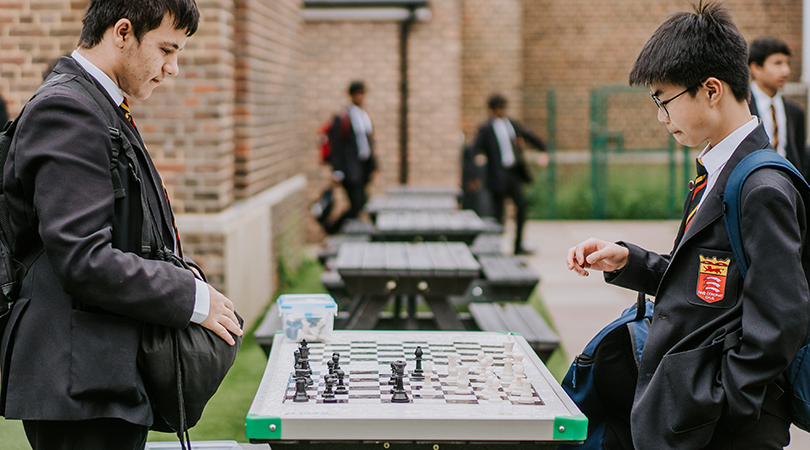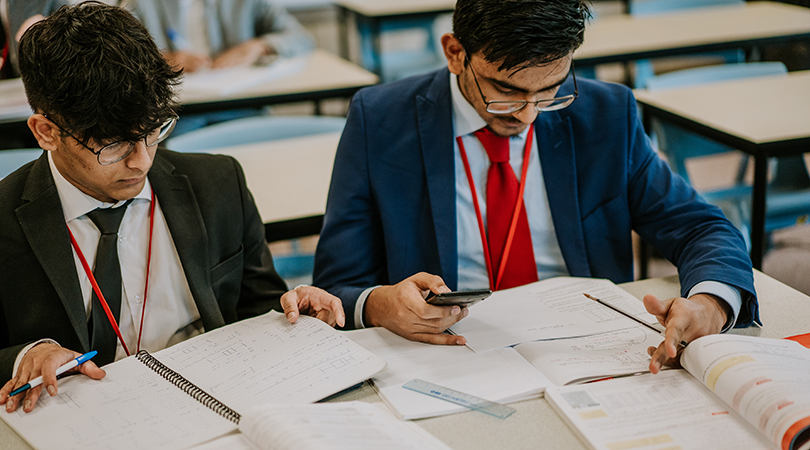 Numeracy is one of our main school priorities, not just in this subject but across the curriculum.
Numeracy is one of our main school priorities, not just in this subject but across the curriculum. We celebrate World Maths Day each year and enter students into the UKMT Maths Challenge at all levels!
We celebrate World Maths Day each year and enter students into the UKMT Maths Challenge at all levels! Students have the opportunity to play chess at breaktimes and lunchtimes, as well as join a dedicated club.
Students have the opportunity to play chess at breaktimes and lunchtimes, as well as join a dedicated club. Mathematics remains very popular at A level, and we also offer further mathematics to allow students to push themselves.
Mathematics remains very popular at A level, and we also offer further mathematics to allow students to push themselves.
Having strong number skills is associated with improved health, financial security and happiness in later life. At Isleworth & Syon, we are equally as proud of the fact that we are preparing our boys for a better future as we are of our strong examination results and the number of boys who go on to study mathematics at university.
Summary
We start with a strong focus on number skills so that pupils are not only fluent in the basics, but can apply them to different settings, identify misconceptions and use them to solve problems. At all stages, extension activities are available in the form of more challenging problems aimed both at developing a deep understanding of the topic and making the next steps in gaining knowledge.
Curriculum Content
Curriculum
Autumn Term
- Introduction to Algebra
- Key Numeracy Skills
- 2D Shapes
- Percentages
Spring Term
- Collecting Data
- Equations
- 3D Shapes
- Averages
Summer Term
- Sequences
- Problem Solving Skills
Assessment
Ongoing Assessments
Regular low-stakes assessments in class will allow students to demonstrate their understanding of the most recent unit that they have covered. Teachers respond to the work in these assessments to indicate the next steps in learning. There are also end of term assessments which cover the topics studied in that term.
End-of-Term Assessments
These will be used to judge boys progress across the key elements of maths: numeracy, algebra, data handling and shape.
End of Year
End-of-year examinations provide the opportunity for boys to demonstrate the progress they have made towards becoming rounded mathematicians.
Progress & Preparation Activities (PPA)
PPA is set on Insight / Parent Portal by class teachers generally on a weekly basis.
Further Resources
The school has a subscription to The Day, an online news service for schools. Click the button to the right, then browse ‘Subjects’ in the top menu to find maths resources.
Tasks will be set weekly using the Dr. Frost Maths website. This is also an excellent resource for revision including videos and accurate tracking of what each boy has learnt about during their home learning.
Curriculum
Autumn Term
- Ratio and proportion
- Displaying Data
- Transformations
- Graphs
Spring Term
- Interpreting Data
- Number Properties
- Circles
- Inequalities
Summer Term
- Constructions
- Probability
- Financial Literacy
Assessment
Ongoing assessments
Regular low stakes assessments in class will allow students to demonstrate their understanding of the most recent unit that they have covered. Teachers respond to the work in these assessments to indicate the next steps in learning. There are also end of term assessments which cover the topics studied in that term.
End-of-Term Assessments
These will be used to judge boys progress across the key elements of maths: numeracy, algebra, data handling and shape.
End of Year
End-of-year examinations provide the opportunity for boys to demonstrate the progress they have made towards becoming rounded mathematicians.
Progress & Preparation Activities (PPA)
PPA is set on Insight / Parent Portal by class teachers generally on a weekly basis.
Further Resources
The school has a subscription to The Day, an online news service for schools. Click the button to the right, then browse ‘Subjects’ in the top menu to find maths resources.
Tasks will be set weekly using the Dr. Frost Maths website. This is also an excellent resource for revision including videos and accurate tracking of what each boy has learnt about during their home learning.
Tasks will be set weekly using the Dr. Frost Maths website. This is also an excellent resource for revision including videos and accurate tracking of what each boy has learnt about during their home learning.
Summary
GCSE Mathematics
Level: GCSE
Examination Board: Edexcel
Curriculum
Number
- Integers and place value
- Decimals
- Indices, powers and roots
- Factors, multiples and primes
Algebra
- The basics
- Expanding and factorising single brackets
- Expressions and substitution into formulae
Graphs, tables and charts
- Tables, charts and graphs
- Pie charts
- Scatter graphs
Fractions, decimals and percentages
Equations, inequalities and sequences
Angles
- Properties of shapes, parallel lines and angle facts
- Interior and exterior angles of polygons
Averages and range
- Statistics and sampling
- The different averages
Perimeter, area and volume
Number
- Calculations and checking
- Indices, roots, hierarchy of operations
- Factors, multiples and primes
- Standard form and surds
Algebra
- Basics
- Setting up, rearranging and solving equations
- Sequences
Graphs
- Basics and real-life graphs
- Linear graphs and coordinate geometry
- Quadratic, cubic and other graphs
Area and volume
- Perimeter, area and circles
- 3D forms and volume, cylinders, cones and spheres
- Accuracy and bounds
Transformation and constructions
- Transformations
- Constrictions, loci and bearings
Interpreting and representing data
- Averages and range
- resenting and interpreting data
- Scatter graphs
Fractions, ratio and proportion
- Fractions
- Percentages
- Ratio and proportion
Assessment
Ongoing assessments
Regular informal assessments in class will allow students to demonstrate fluency, reasoning, application, a knowledge of misconceptions and the ability to solve problems. These are all contained in the Mastery Folders that each of our boys has at school. Teachers respond to the work in these booklets to indicate the next steps in learning.
Termly and End of Year
Examinations provide the opportunity for boys to demonstrate the progress they have made towards becoming rounded mathematicians. Tests in Year 9 start to include questions from GCSE examinations.
Progress & Preparation Activities (PPA)
PPA is set on Insight / Parent Portal by class teachers generally on a weekly basis.
Further Resources
The school has a subscription to The Day, an online news service for schools. Click the button to the right, then browse ‘Subjects’ in the top menu to find maths resources.
Tasks will be set weekly using the Dr. Frost Maths website. This is also an excellent resource for revision including videos and accurate tracking of what each boy has learnt about during their home learning.
Please see below for a number of resources to maximise students’ progress during their Year 9 curriculum.
- NRICH – resources, articles and challenges for able lower secondary pupils.
- 5-a-day – students can benefit massively by completing the foundation questions from this site. Everybody knows you need your 5 a day!
- Dr. Frost Maths – excellent source of independent revision including videos and tracking of progress across the key skills.
- Corbett Maths – topic-specific past examination questions. Very useful for targeted revision time.
- Maths Genie – the best website to find free-to-access full past papers.
Curriculum
In Year 10, students will study the following topics:
Graphs, tables and charts
- Tables, charts and graphs
- Pie charts
- Scatter graphs
Graphs
- Real-life graphs
- Straight-line graphs
Averages and range
- Statistics and sampling
- The averages
Transformations
- Translations, rotations and reflections
- Enlargements and combinations
Probability
Right-angles triangles
- Pythagoras and trigonometry
Multiplicative reasoning
Constructions, loci and bearings
- Plans and elevations
- Constructions, loci and bearings
Quadratic equations and graphs
- Expanding and factorising
- Quadratic graphs
Perimeter, area and volume
- Circles, cylinders, cones and spheres
Graphs
- Basics and real-life graphs
- Linear graphs and coordinate geometry
- Quadratic, cubic and other graphs
Transformation and constructions
- Transformations
- Constrictions, loci and bearings
Interpreting and representing data
- Averages and range
- Representing and interpreting data
- Scatter graphs
Further statistics
- Collecting data
- Cumulative frequency, box plots and histograms
Angles and trigonometry
- Polygons, angles and parallel lines
- Pythagoras’ Theorem and trigonometry
Equations and inequalities
- Solving quadratic and simultaneous equations
- Inequalities
Probability
- Equations and graphs
- Quadratics, expanding more than two brackets, sketching graphs, graphs of circles, cubes and quadratics
Circle theorems and circle geometry
Assessment
Ongoing assessment in class provides opportunities for feedback on how pupils can improve. An end of year exam gives a measure how pupils are progressing towards the examinations in Year 11.
External examinations in Year 10 are for GCSE Statistics (see below), not GCSE Mathematics.
Progress & Preparation Activities (PPA)
PPA is set on Insight / Parent Portal by class teachers generally on a weekly basis.
Further Resources
The school has a subscription to The Day, an online news service for schools. Click the button to the right, then browse ‘Subjects’ in the top menu to find maths resources.
Tasks will be set weekly using the Dr. Frost Maths website. This is also an excellent resource for revision including videos and accurate tracking of what each boy has learnt about during their home learning.
Please see below for a number of resources to maximise students’ progress during their Year 10 curriculum.
- NRICH – resources, articles and challenges for able lower secondary pupils.
- 5-a-day – students can benefit massively by completing the foundation questions from this site. Everybody knows you need your 5 a day!
- Dr. Frost Maths – excellent source of independent revision including videos and tracking of progress across the key skills.
- Corbett Maths – topic-specific past examination questions. Very useful for targeted revision time.
- Maths Genie – the best website to find free-to-access full past papers.
Curriculum
In Year 11, students will study the following topics:
- Algebra, equations, inequalities and sequences
- Angles, perimeter, area and volume
- Transformations
- Ratio and proportion
- Right-angles triangles
- Construction, loci and bearings
- Quadratic equations and graphs
- Fractions, indices and standard form
- Congruence, similarity and vectors
- Standard form and surds
- Percentages
- Solving equations and simplifying algebraic fractions
- Proportion, ratio and scale
- Function notation
- Transformations
- Pythagoras’ Theorem and trigonometry
- Circle geometry
- Direct and indirect proportion
- Solving quadratic equations
- Transformations of graphs
Assessment
Written examination (calculator 1) – 1 hour 30 minutes – 33.3% of GCSE
Written examination (calculator 2) – 1 hour 30 minutes – 33.3% of GCSE
Written examination (non-calculator) – 1 hour 30 minutes – 33.3% of GCSE
Further Resources
The school has a subscription to The Day, an online news service for schools. Click the button to the right, then browse ‘Subjects’ in the top menu to find maths resources.
Tasks will be set weekly using the Dr. Frost Maths website. This is also an excellent resource for revision including videos and accurate tracking of what each boy has learnt about during their home learning.
Please see below for a number of resources to maximise students’ progress during their Year 11 curriculum.
- NRICH – resources, articles and challenges for able lower secondary pupils.
- 5-a-day – students can benefit massively by completing the foundation questions from this site. Everybody knows you need your 5 a day!
- Dr. Frost Maths – excellent source of independent revision including videos and tracking of progress across the key skills.
- Corbett Maths – topic-specific past examination questions. Very useful for targeted revision time.
- Maths Genie – the best website to find free-to-access full past papers.
GCSE Statistics
Level: GCSE
Examination Board: Edexcel
Curriculum
Topics are integrated with the GCSE Mathematics curriculum above.
Assessment
Written examination – 1 hour 30 minutes – 50% of GCSE
Written examination – 1 hour 30 minutes – 50% of GCSE
These will be sat in the summer term of Year 10.
Further Resources
The school has a subscription to The Day, an online news service for schools. Click the button to the right, then browse ‘Subjects’ in the top menu to find maths resources.
Tasks will be set weekly using the Dr. Frost Maths website. This is also an excellent resource for revision including videos and accurate tracking of what each boy has learnt about during their home learning.
Please see below for a number of resources to maximise students’ progress during their Year 10 curriculum.
- BBC Bitesize: GCSE Statistics – several videos applying the statistics taught in the course to the real world.
- YouTube: Statistics Revision Videos – good explanations of some key topics.
Summary
A level Mathematics
Level: A-Level
Examination Board: Edexcel
Curriculum
In Year 12, students take the following topics:
- Pure, covering the following topics: Algebra & Functions, Coordinate Geometry in the (x,y) plane, Sequences & Series, Differentiation, and Integration.
- Statistics, covering the following topics: Measures of Spread, Probability, Correlation, Regression, Discrete Random Variables and the Normal Distribution.
- Mechanics, covering the following topics: Kinematics, Collisions, Dynamics, Statics, Moments and Vectors
In Year 13, students will continue to study Pure, Statistics and Mechanics, expanding on the concepts they start in Year 12.
Assessment
Chapter Tests
There will be regular chapter tests (normally 2 or 3 chapters combined) to allow us to track students understanding and their progress through the year.
End of Year 12
There will be a formal end of year assessment used to assess whether students have made enough progress and what additional interventions need to be in place to help them achieve their best in Year 13.
Examinations
Assessment in by examination at the end of Year 13. This consists of three 2-hour written papers, the first two papers cover Pure Mathematics and Paper 3 is the Statistics and Mechanics paper. Each paper is weighted equally and each paper can cover topics covered in either Year 12 or Year 13.
Further Resources
The school has a subscription to The Day, an online news service for schools. Click the button to the right, then browse ‘Subjects’ in the top menu to find maths resources.
Tasks will be set weekly using the Dr. Frost Maths website. This is also an excellent resource for revision including videos and accurate tracking of what each boy has learnt about during their home learning.
Please see below for a number of resources to maximise students’ progress during their Year 12 curriculum.
- Maths Genie – the resources here are mostly past examinatiion papers but there is also an increasing number of topic-specific resources appearing regularly.
- Dr. Frost Maths – this site has videos, activities and full lessons available for all students. PPA may also be set through Dr. Frost.
- Exam solutions – videos explaining how to complete past exam questions. The best way to use this website is to attempt the question and then compare your working with the video.
- UK Maths Challenge activities (Junior, Intermediate, Senior)
- Team mathematics competitions
- KS3 PPA club

